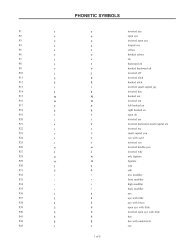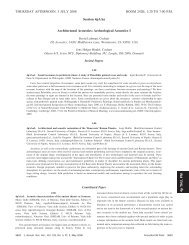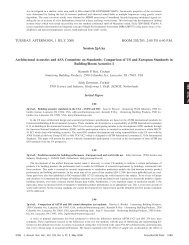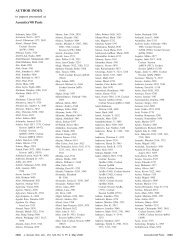Tuesday afternoon, 11 November - The Acoustical Society of America
Tuesday afternoon, 11 November - The Acoustical Society of America
Tuesday afternoon, 11 November - The Acoustical Society of America
Create successful ePaper yourself
Turn your PDF publications into a flip-book with our unique Google optimized e-Paper software.
could disturb occupants in the lower theater. Upgrading the structure is complicated by the location <strong>of</strong> the building which sits directly<br />
above a metro tunnel and therefore has strict weight requirements. <strong>The</strong> approach currently proposed is to include a floating concrete<br />
floor and sound barrier ceiling. Chris Pollock SMW, Rima Namek and Diane Cho Cho Benn Holback, Millie Dixon and John Coyne<br />
<strong>The</strong>atre Projects, and Vincent Lancisi Everyman <strong>The</strong>atre.<br />
3:40<br />
2pAA8. 939 Cafe at Berklee College <strong>of</strong> Music: From an old <strong>of</strong>fice to a performing space. Ioana Pieleanu Acentech Inc., 33 Moulton<br />
St., Cambridge, MA 02138<br />
Long due for the world renowned jazz and contemporary music school, and open in October 2007, the 939 Cafe is the first club-type<br />
performing space at Berklee College <strong>of</strong> Music in Boston. Given the urban location <strong>of</strong> the college and the shortage <strong>of</strong> available real estate<br />
in the area, the Cafe is a retr<strong>of</strong>it <strong>of</strong> an old architect’s <strong>of</strong>fice space. Among the Cafe’s neighbors in the building there is the Bostons<br />
Tennis and Racket Club, a building tenant since 1902, and an independent restaurant/bar. All aspects <strong>of</strong> the acoustical design, including<br />
the room acoustics, sound isolation, and mechanical system noise control, presented challenges in this limited volume historical setting.<br />
This presentation discusses these challenges, limitations, and the proposed acoustical solutions.<br />
4:00<br />
2pAA9. Acoustic challenges <strong>of</strong> converting a historical hall to multipurpose use. Anthony Bontomase and Kristin Bleedorn Shen<br />
Milsom Wilke, 417 Fifth Ave., New York, NY 10016, abontomase@smwinc.com<br />
<strong>The</strong> Great Hall <strong>of</strong> the historical Cunard Building in New York City was originally used for the Cunard passenger ship lines ticketing<br />
beginning in 1921 and later converted to a US Post Office branch. After years <strong>of</strong> vacancy, a hospitality company proposed to take<br />
advantage <strong>of</strong> the attractive Renaissance Revival inspired hall for events ranging from speeches to weddings and concerts. <strong>The</strong> Great Hall<br />
features a huge vaulted ceiling and is surrounded by occupied <strong>of</strong>fice spaces, with original windows between. <strong>The</strong> acoustic goals were<br />
to reduce sound transmission into <strong>of</strong>fices and to tame the reverberation time to accommodate various programs. Several acoustic tests<br />
were performed to establish the reverberation time and the noise isolation class between the hall and <strong>of</strong>fices. Further testing with windows<br />
covered overyielded the achievable noise isolation without modification <strong>of</strong> walls within <strong>of</strong>fice spaces. Only nonpermanent interior<br />
acoustic treatments were permitted as preserving the visual appeal <strong>of</strong> the interior is critical. Insulating glass additions on the interior <strong>of</strong><br />
<strong>of</strong>fices is expected to provide a noise isolation class above 50. <strong>The</strong> use <strong>of</strong> carpet and suspended drapery is expected to reduce the<br />
reverberation time to be more manageable for a variety <strong>of</strong> programs.<br />
4:20<br />
2pAA10. Recording studio rehabilitation. Marshall Long Marshall Long<br />
Acoust., 13636 Riverside Dr., Sherman Oaks, CA 91423<br />
From time to time projects are designed and built, which do not perform<br />
in the expected manner. Sometimes outside events interfere with the design<br />
intent. In other cases there is a fundamental misunderstanding <strong>of</strong> the technical<br />
principles involved. This is an example <strong>of</strong> one <strong>of</strong> these cases. A recording<br />
studio was designed by a well known studio designer, who shall<br />
remain nameless and built on the first floor <strong>of</strong> a multistory high rise in Los<br />
Angeles, CA. It consisted <strong>of</strong> a studio approximately 201810 ft 3 high and<br />
an adjacent control room. A 3-in. concrete floor was isolated on 1/2-in. rubber<br />
and the walls and ceiling were built independently on top <strong>of</strong> the floor.<br />
After completion both footfall and carts being pushed along a corridor approximately<br />
15 ft away were clearly audible inside the studio. This paper<br />
describes the steps taken to analyze and correct the problem.<br />
4:35<br />
2pAA<strong>11</strong>. Multithread implementation for calculating room impulse<br />
responses. Wolfgang Ahnert, Stefan Feistel, and Alexandru Miron Ahnert<br />
Feistel Media Group Berlin, Arkonastr. 45-49, 13189 Berlin, Germany,<br />
wahnert@ada-acousticdesign.de<br />
Modern simulation programs are committed to calculate full impulse responses<br />
instead <strong>of</strong> doing simple mapping presentations. <strong>The</strong> main problem<br />
here is how to obtain such IRs quickly but accurately. <strong>The</strong> usual algorithm<br />
simulates sound propagation by tracing a statistical ensemble <strong>of</strong> acoustic<br />
rays. In this contribution, we deal with a new ray-triangle intersection<br />
algorithm, based on a three-dimensional grid scheme, that provides significant<br />
performance improvement for ray tracing. We report about the introduction<br />
<strong>of</strong> a uniform grid ray-tracing algorithm, which is optimized for<br />
acoustic models and can be up to five times faster standard Pentium 4 than<br />
hierarchical space decomposition. Furthermore, the algorithm has been<br />
Contributed Papers<br />
parallelized, taking advantage <strong>of</strong> the inherently independent propagation <strong>of</strong><br />
distinct rays. On multicore processors, the computation employs a variable<br />
number <strong>of</strong> thread tracing groups <strong>of</strong> rays in parallel. <strong>The</strong> speed increase is<br />
almost linear with the number <strong>of</strong> cores. An overview is given to explain this<br />
approach. To support this fast calculation, an additional algorithm derives a<br />
suggested particle number and length from the mean free path properties <strong>of</strong><br />
the room and the desired detection rate at the receiver. So time-consuming<br />
guesses about the selecting particle numbers will be avoided.<br />
4:50<br />
2pAA12. Swept sine against maximum length sequences in room<br />
acoustics with music signals as background noise. Joel Paulo DEETC,<br />
ISEL -Tecnical Inst. <strong>of</strong> Lisbon, Rua Conselheiro Emídio Navarro 1, Lisbon,<br />
1959-007, Portugal, jpaulo@deetc.isel.ipl.pt and José Bento Coelho CAPS<br />
- Instituto Superior Tcnico, Lisbon, Portugal<br />
<strong>The</strong> Swept Sine and the MLS techniques are very popular in room<br />
acoustic measurement set-ups. Advantages and disadvantages <strong>of</strong> both methods<br />
have been well investigated and can be found in the literature. However,<br />
information regarding the performance <strong>of</strong> these techniques in the presence<br />
<strong>of</strong> high background music levels is scarce. Since the estimation <strong>of</strong> the room<br />
impulse response is based on the correlation between signals, the likelihood<br />
between the test signal and the music contents plays an important role on the<br />
results’ accuracy. This paper explores these issues by taking into account the<br />
semantic information <strong>of</strong> the music signals when used as disturbance. <strong>The</strong><br />
method used for the assessment <strong>of</strong> the gain between the two techniques consists<br />
<strong>of</strong> splitting each frame into segments and applying a weighting function<br />
depending on a likelihood function. <strong>The</strong> features used for the likelihood<br />
function are the rms value <strong>of</strong> each segment, spectral energy envelope relation,<br />
bandwidth and harmonic structure. Several examples are presented for<br />
comparison <strong>of</strong> the performance <strong>of</strong> the Swept Sine and the MLS techniques.<br />
Advantages and disadvantages <strong>of</strong> each technique are discussed for music<br />
signals as noise.<br />
2481 J. Acoust. Soc. Am., Vol. 124, No. 4, Pt. 2, October 2008 156th Meeting: <strong>Acoustical</strong> <strong>Society</strong> <strong>of</strong> <strong>America</strong><br />
2481<br />
2p TUE. PM







